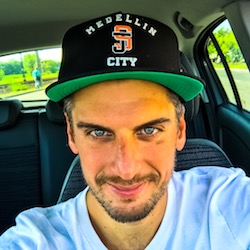or use arrow keys
matrix3d
SINGAPORE
Thursday 25th
Registration
Capitol Theatre at 11 Stamford Rd
Please bring your ticket with the QR code and a photo ID
Opening

CSS Blend Modes, Because...
Una Kravets @una
CSS Blend modes are underutilized and can be used for a variety of things from improving image performance to creating scalable styling. This talk goes over some case studies where blend modes can make a big impact, talks about browser support, and also discusses workaround for including blend modes where they aren't supported.
Tour the wide world of CSS Blend modes and learn why you may want to introduce them in your own web-based projects today!
Una is an international speaker, technical writer, open source advocate, and Senior UI Engineer at DigitalOcean.
She’s written for various online publications such as A List Apart, Smashing Magazine, and Sitepoint. Una also co-hosts the Toolsday podcast and started both the DC and Austin Sass Meetups. She's a performance nerd, loves the open source community and listens to way too many audio books.

Performing Dynamic Analysis of JS Apps
Inian Parameshwaran, Dexecure @everConfusedGuy
Ever wondered how many times the ads in your website are using document.write? Or if you were writing to the DOM from untrusted sources? Such questions can be answered by dynamically analysing the JavaScript running in your website. Static analysis of JavaScript leads to a lot of false positives and is incredibly hard to do correctly due to features like eval, XHR, etc. Dynamic analysis of JavaScript gives much more accurate results. I will talk about using meta programming APIs such as Proxies, overriding native DOM APIs and inbuilt JS functions, using Immediately Invoked Function Expressions (IIFEs), etc. to carry out your own dynamic analysis, the gotchas involved and how I handled them. Also, I will be demonstrating how to use the open-source proxy module I wrote, which makes it easy to get started on carrying out these kinds of dynamic analysis on real-world web applications.
Inian is the founder of a web performance company, Dexecure. He loves JavaScript, chocolates and anything related to web performance and security. He is a strong believer in the importance of having an open, decentralised and uncensored web ecosystem.

Write Perfect Code with Standard and ESLint
Feross Aboukhadijeh @feross
In this talk, you'll learn about code linting – how to use Standard and ESLint to catch programmer errors before they cause problems for your users. We'll discuss how to get started with linting, as well as how to improve your setup if you're already linting your code. Feross will also share the secret history of how the Standard linter was created, for the first time ever in a conference talk.
Feross is a mad scientist who enjoys building software that makes people say "Wow, I didn't know that was possible!". Since graduating from Stanford in 2012, he's worked on PeerCDN and maintains several popular open source projects including WebTorrent and Standard. He's currently working on a new website for Node.js documentation.


Be a No-Mouse Ninja: How People with Visual Impairment use Websites
Giang Nguyen, Grab
Dickson Tan
What does it take to navigate a website with your eyes closed? Let Giang & Dickson, pioneers of the Web Accessibility (A11Y) movement in Singapore, walk you through the daily challenges they face, what it means to them, and how their experiences interfacing with websites purely through audio can help you identify new experiences for your sighted users through case examples.
Giang earned himself a computer science scholarship in Vietnam, interned at Intel and Captcha before joining Grab as the companies first fully blind coder. Today he manages accessibility at Grab and co-leads (these)abilities’ Web & Mobile Accessibility Initiative.
A true lifehacker at heart, Dickson is pursuing a degree in Computer Science in the NUS School of Computing and represents Singapore at accessibility conferences. He interned at Singtel IT and GovTech and is also the co-lead for (these)abilities’ Web & Mobile Accessibility Initiative.
Highly distributed lunch


data sketch|es: a year of exotic data visualizations
Shirley Wu @sxywu
Nadieh Bremer @NadiehBremer
Data sketches is a collaboration between Nadieh Bremer and Shirley Wu, where we choose a topic and visualize it by the end of the month, and write about our process. In this talk, we will share our favorite months of data, sketches, and code: what made them our favorites, the mistakes we made along the way, and how we overcame them. We want to share our lessons learned to highlight that, though many of our visualizations had humble, ugly duckling beginnings, we were able to produce unique and compelling results through many (embarrassing) iterations.
Shirley is a freelance software engineer specializing in data visualization.
She combines her love of art, math, and code into colorful, interactive data visualizations.
She enjoys finding fun insights in data and weaving them into stories and exploratory tools
for the reader to discover.
Her work can be found at sxywu.com.
Nadieh is a graduated Astronomer, turned Data Scientist,
turned self-taught Data Visualization Designer.
After working for a consultancy & fintech companies where she discovered
her passion for the visualization of data, she's now working as a freelancing
data visualization designer under the name Visual Cinnamon.

Micro Frontend: a microservice architecture from your frontend web apps
Wilson Mendes @willmendesneto
Are you working with a big Frontend application and you are facing some problems in your project? Do you want migrate your frontend from another framework or library and don’t know how? Don't you know how to manage different layers of complexity in your application or share these components between applications?
In this talk, I will share my experience and decisions creating micro frontend applications, how to manage quality, deployment and more that makes your team deliver more valuable features giving you the power to migrate, improve, evolve and experiment in your product.
Wilson is a Google Developer Expert on Angular and Web Technologies and international speaker. He is passionate OSS contributor and active in the communities around Angular, JavaScript, HTML5, CSS3, Workflow, web performance, security and Internet of things.

 Serverless Apps with Node.JS in OpenWhisk and Adobe I/O Runtime
Serverless Apps with Node.JS in OpenWhisk and Adobe I/O Runtime
Shazron Abdullah, Adobe @shazron
Serverless computing is a powerful way for JavaScript developers to create backend services that can power a variety of experiences from the browser to IoT devices. At Adobe, we are embracing serverless as a way to enable our developer ecosystem to easily create experience applications that extend our solutions. We’re building this platform, Adobe I/O Runtime, on top of an open source project, Apache OpenWhisk. In this talk you’ll learn about Apache OpenWhisk, what kinds of use cases are good for serverless, and how to use build serverless applications using NodeJS. Using Adobe I/O Runtime, you’ll see how to deploy code as serverless functions, how event-driven architecture can be a powerful compliment for serverless, how to build more complex applications by combining multiple functions, and how to expose your functions as APIs so they can be used across multiple experiences. You’ll walk away with a clear picture of where it makes sense to use serverless computing and how to get started.
Based in San Francisco, by way of Vancouver, Canada and Singapore, Shaz has nearly two decades of software development experience getting with the nitty gritty of Windows, OS X and iOS and probably helped code something you know. Currently he is on the Adobe I/O team and also helps maintain the iOS platform of Apache Cordova + Adobe PhoneGap and has been part of that project for quite some time.

Honey, I Shrunk the Scripts! — the secret life of JS on microcontrollers
István Szmozsánszky "Flaki", Mozilla @slsoftworks
In 2015 I published an article on JavaScript's "World Domination". Back then, a bit more than two years ago, in this 6000-word beast JavaScript on hardware was almost like an afterthought, a footnote on the last page and a bit. But even then, the writing was already on the wall — it was only a matter of time until JavaScript's triumphant march reached the most minute of the silicone army… Indeed,two years later, there's already this thriving ecosystem of tiny JavaScript-dialects: they are powering a wide variety of miniature computers (colloquially only referred to as ""IoT""), from industry automations to smartwatches, they are everywhere. My bet is, even if you have never heard of JerryScript, duktape, or V7 before — you surely will want to now. ;)
István (or Flaki, for short) is a JavaScript world-domination prophet, engineer & trainer from Budapest. He runs his own consulting business Skylark, is a Frontend Trainer @ DPC Consulting and a longtime Mozilla-contributor. He contributes to various open source projects like Firefox, Firefox OS, Rust, Servo and the Tessel Project.
His favorite topics include service workers, progressive webapps and JS on microcontrollers.
Stretch your legs

 Evolving DBS Frontend
Evolving DBS Frontend
Tony Sebastian, DBS@tsktony
Over the last year, DBS frontend architecture for building customer facing applications has evolved to keep pace with the rapid advancement happening in the JavaScript world. Get excited how we approached and executed changes on large enterprise frontend.
Tony is a digital product development leader at DBS Bank in Singapore, with experience in delivering large and complex web and mobile products and infrastructure in the e-commerce, financial services and payments industry.

When East meets West: web typography and how it can inspire modern layouts
Chen Hui Jing @hj_chen
This talk traces the parallel history of western and eastern typography from handwriting to the internet age, setting the context for how the web is a brand new medium for typesetting. CSS allows us to implement advanced typographic features and multi-directional layouts, that not only benefits internationalisation, but opens up a myriad of options for creative and interesting layouts in general as well.
Hui Jing is a self-taught designer and developer with an inordinate love for CSS. Reducing lines of code in her web projects makes her extremely happy. She used to play basketball full-time and launched her web career during downtime between training sessions.

My Node.js process is on fire
Matteo Collina, nearForm @matteocollina
At 10am on Black Friday, your phone rings: the new JS application you deployed came under too much load, and the site has gone down! Your employer is losing sales opportunities... your employer is losing money! But you don’t lose your cool. You log into your cloud provider and tweak your autoscaling settings. Now the deployment can handle the load spike but with four times the number of servers, which is four times the cost. The next day, you try to analyze what happened and begin to optimize your application to prepare for future load spikes. This talk is a journey into the world of Node.js performance, taking a look at the available tools and optimization techniques inspired by insight gained from glimpsing under the hood of Node and V8.
Matteo is a code pirate, mad scientist and part of the Node.js Technical Steering Committee. As a Principal Architect at nearForm, he consults for the top brands of the world. He authored Node.js MQTT Broker, Mosca, the fast logger Pino and the Fastify web framework.

 Enabling New Web Experiences
Enabling New Web Experiences
David Bryant, Mozilla @david_bryant
Speech, mixed reality and machine learning are all the rage. How do we incorporate these emerging technologies into today’s web and provide enriching opportunities for creators and compelling experiences for users? How do we make those experiences buildable and deployable at scale to everyone, everywhere? Come hear how Mozilla blends established core web components like JavaScript with breakthrough new capabilities like WebAssembly and powerful new programming languages like Rust to transform the web.
David is a Fellow in Mozilla’s Emerging Technologies group, providing technical expertise for Mozilla's engineering and leads its Developer Outreach team. Before this he led product engineering, marketing, sales enablement and technology licensing at Bell Labs, Sun and Nokia. Throughout his career David has been motivated to build Internet and computing solutions that matter to people.
Friday 26th
Workshop and Community Day
Shangri-La Rasa Sentosa Resort and Spa
Pick your workshops during ticket sign-up. Seats are limited.

The Node.js Performance Workshop
Matteo Collina, nearForm @matteocollina
We’ve been discovering how to write performant JavaScript in Node.js since the beginning.
Before we knew how it was it done it all seemed so magical. But as we became better at
understanding fast-scrolling text littered with hex addresses we began a journey to solidify our approach and share it with others. Our primary strategy? Build tools that make optimizing Node easier, then formalize a workflow process around those tools.
The workshop is extremely interactive. We make sure that each participant solves several performance issues in a given HTTP application. Our methods and tools include 0x for flamegraph generation, autocannon for HTTP/1.1 benchmarking, v8 trace analysis, and bytecode interpretation all within a structured analysis workflow.
Requirements: Participation requires a recent version of either Linux or macOs, or otherwise a VM running a recent Linux version.
They will need root/admin access, and the ability to build native node modules. Follow these instructions.
Matteo is a code pirate, mad scientist and part of the Node.js Technical Steering Committee. As a Principal Architect at nearForm, he consults for the top brands of the world. He authored Node.js MQTT Broker, Mosca, the fast logger Pino and the Fastify web framework.

WebVR with A-Frame - Getting started
Martin Splitt @g33konaut
VR is cool, Web is great - how about WebVR?
In this workshop we will be creating a WebVR application using A-Frame.
We will explore the WebVR API and the A-Frame library to build a small VR application that works in your browser - even on your phone!
Requirements: Make sure your laptop is capable of rendering 3D graphics in the browser by visiting https://get.webgl.org - if you see a spinning cube, you're ready.
If you have a smartphone that is WebGL capable, bring it too (and have it charged)!
Martin is open source contributor, WebGL tinkerer and web evangelist by heart from Zurich
with a decade experience from the trenches of software engineering in multiple fields.
He works as a software engineer at Archilogic in front- and backend.
He devotes his time to moving the web forward, fixing problems, building applications and systems
and breaking things for fun & profit.

Clouduboy - create JS games for microcontrollers
Szmozsánszky István "Flaki", Mozilla @slsoftworks
Explore, tinker, play - learn how to create your very own retro pixelart games for the Arduboy, a tiny Arduino-based pocket-sized game console reminiscent of Gameboy's glory days. Best thing? Thanks to Clouduboy you can now do this entirely in your browser, all in JavaScript with the language and techniques you already know (and love)!
Requirements:
The only thing needed is a PC/Mac with an up-to date browser and a USB-A port for flashing the microcontrollers. All software will be provided or will run in the browser. JavaScript-programming experience at this workshop is recommended, but Clouduboy's "Learn to Code!" tutorial itself is suitable for learners of any levels of programming experience (including people who never coded before).
István (or Flaki, for short) is a JavaScript world-domination prophet, engineer & trainer from Budapest. He runs his own consulting business Skylark, is a Frontend Trainer @ DPC Consulting and a longtime Mozilla-contributor. He contributes to various open source projects like Firefox, Firefox OS, Rust, Servo and the Tessel Project.
His favorite topics include service workers, progressive webapps and JS on microcontrollers.

 Enliven UX with React/Redux
Enliven UX with React/Redux
Gurudath Reddy, Palo IT
Learn how to better use React/Redux for building awesome user experiences, using optimistic transactions and data preloads. Also, we will explore advanced topics such as Hot Code Reload, Testability, Performance Monitoring, etc.
Requirements:
Latest version of NodeJS and NPM installed before the session.
A Tech Lead and Frontend Architect at PALO IT, Guru is responsible for leading many frontend projects for global banks. His expertise includes, but not limited to, both worlds of Angular and React. He is also a stern believer in Agile, strives to find ways to make processes simpler using technology, and loves to use design thinking recipes to frame problem statements, prototype and find solutions.

CSS Grid is the new black
Chen Hui Jing @hj_chen
Do you cringe when you have to design and build layouts on the web? Do you get frustrated when things never go where you want them to on your page?
Creating custom layouts is not a trivial task, no matter what your sales rep or account manager says. Fortunately, browsers now support a plethora of CSS properties that make building creative layouts much less painful than before.
This workshop will cover a range of techniques for building cutting-edge web layouts with fallbacks for older browsers as well. It will be a practical workshop with code examples you can refer to for your future projects.
Hui Jing is a self-taught designer and developer with an inordinate love for CSS. Reducing lines of code in her web projects makes her extremely happy. She used to play basketball full-time and launched her web career during downtime between training sessions.

Scalable CSS
Chris Lienert @cliener
Writing and maintaining CSS for one site is very different from two… or five… or more! We'll get hands-on with different methodologies and learn how to go large with CSS without losing our minds along the way.
Requirements:
Bring a laptop and a code editor of some description. Shortly before the workshop, please clone this repo.
Chris started out as a web developer when Netscape ruled the world and is currently an engineering manager at CXA in Singapore. He has written for Net Magazine and SitePoint, and founded community group Singapore CSS because someone had to. Aside from musical distractions and accumulating frequent flyer points, Chris and his wife Sarah can be found in the company of their small human.

The Big Node.js Bot Party (Part 1)
Pasindu De Silva @Ghosteyes1
The workshop will be on creating robots using JS. We hope to have people build party themed robots. The first 2 hours we will be teaching about getting started and how to control each device (servos, LED etc). After this the attendees can come up with there own idea about a party robot they would like to make and the build it with the rest of the time.
Requirements:
Install Arduino IDE. Have NodeJS installed. Make sure your USB connections work.
Pasindu works on building open source text to speech systems for low resource languages by day and does various JavaScript Nodebots projects by night.

Fullstack JavaScript (Part 1)
Tamas Piros @tpiros
In this workshop we'll take a look at how to develop fullstack JS applications especially concentrating on the latest and greatest features of JavaScript itself (ES2015) and because we are adding Angular to the mix we'll also learn TypeScript. We'll also design a REST API and finally learn about NoSQL as well via an enterprise grade database (that is also capable of running JavaScript!)
Requirements:
Ideally the latest Node.js 8.x or 9.x installed along with their favourite code editor (Visual Studio Code recommended).
Fullstack Developer Academy is a blog created by Tamas, who works as a technical trainer & instructor and has a decade of experience working with customers and training them in technologies including but not limited to JavaScript, Angular, Node.js, TypeScript, XQuery, Java, NoSQL and related database technologies and methodologies.
 Hacker Deck by the sea
Hacker Deck by the sea
Friendly coding with a view
Welcome to our Hacker Deck by the sea! Prepare for a free flow of ideas, quick presentations, a robot cocktail treasure hunt, nitro coffee and time to code with wildly amazing people. It's as close as you'll ever see a hackathon at a JSConf. This catch-all session is hosted in a shaded and roofed area outside. Plenty of hydration and tunes to chill will be provided.
Requirements:
Bring a laptop and a charger if you'd like to do some work. Light clothing to change into will be comfier here. It's warm outside in Singapore ;)
Centralised lunch


Ethereum and Javascript - what's the big deal?
Dave Appleton @appletondave
Raman Shalupau @ksaitor
Ethereum is the wunderkid of the blockchain space.
Decentralised Smart Contracts coupled with web3.js mean that you can integrate your distributed app with your front-end to improve your user experience.
Requirements:
A notebook with chrome would be preferable. Good options to install would be parity and/or metamask as well as the usual tools.
Dave is the lead blockchain developer for HelloGold in Malaysia where he attempts to bring a better means of saving to those not well served by the finance industry. Between raising awareness of phishing attacks and scams, he spents his time as a programmer, hardware engineer and lecturer in Singapore and Malaysia.
Raman is a full-stack JavaScript consultant by day and entrepreneur by night. He’s been working with such companies like Redmart, Nugget, Cinarra, Smove and Load Impact. Currently he’s fascinated with the world of cryptocurrencies and playing with Solidity and Smart Contracts on Ethereum. He’s also a founder of Crypto Jobs List.


Augmented City - WebVR with A-Frame advanced
Vanessa Radd @vanradd
Christopher Gomez @chrisgomez
Casual AR and VR on the web allows people to create and consume augmented and virtual experiences easily and more freely. WebVR takes advantage of the web, the largest and most accessible software platform in history, to close the content gap and help AR/VR gather steam with the masses. This Lab lets participants work together to create an VR/AR content for the Web using Mozilla’s A-Frame toolkit.
For this workshop, participants will ideate and do a code/design sprint on the theme 'Augmented City'.
Come together with other web developers to experiment and create AR and VR on the web!
Requirements:
For web developers interested in building AR/VR content and applications.
What to bring: A laptop or other computer is required.
Even if you’re already familiar with designing or programming for AR/VR, run through the A-Frame interactive tutorial: https://aframe.io/aframe-school
Vanessa is a Founding Member of the XR Alliance and President of the global VR/AR Association (VRARA) Singapore Chapter.
She is also the founder of the XR/VR/AR Women in Asia Society and co-founder of the WebVR Asia community.
Christopher is an angel investor and industry mentor to the fields of Deep Technology,
AR and VR, and is a vocal evangelist of these industries globally.
He has led interaction and animation teams and was a key committee member that brought
the SIGGRAPH conference to Asia. Christopher is a Founding Member of the
XR Alliance and co-founder of the WebVR Asia community.


Coding Blindly: Intro to Web A11Y
Giang Nguyen, Grab
Dickson Tan
As developers, we take great pride and responsibility in ensuring a safe and seamless experience for visitors. However, this isn't very much the case for 39 Million blind and visually-impaired people. While America & the EU pledge efforts to make all governmental service websites accessible, there are no systems in place in the APAC region.
Join us to find out what it takes to make a web experience truly seamless for those living with blindness and visual impairment, complete with challenge tasks and some prize swag.
Requirements:
Participants should come prepared with an Apple Laptop (Macbook, Macbook Air) running El Capitan 10.11 minimally,
a laptop charger & a pair of headphones/earphones, a mouse if your trackpad is not working and Firefox browser installed.
Giang earned himself a computer science scholarship in Vietnam, interned at Intel and Captcha before joining Grab as the companies first fully blind coder. Today he manages accessibility at Grab and co-leads (these)abilities’ Web & Mobile Accessibility Initiative.
A true lifehacker at heart, Dickson is pursuing a degree in Computer Science in the NUS School of Computing and represents Singapore at accessibility conferences. He interned at Singtel IT and GovTech and is also the co-lead for (these)abilities’ Web & Mobile Accessibility Initiative.


Creative Data Visualizations with SVG and D3.js
Shirley Wu @sxywu
Nadieh Bremer @NadiehBremer
In this workshop, we will cover the basics of SVG - especially SVG paths and the cubic bezier curve command - as well as an introduction to D3.js's selection, data-binding, and enter-update-exit patterns. The culmination of the workshop will be to create a set of flowers out of movie data, a simpler version of the film flowers here.
Requirements:
Just a laptop and working knowledge of Javascript and the web.
Shirley is a freelance software engineer specializing in data visualization.
She combines her love of art, math, and code into colorful, interactive data visualizations.
She enjoys finding fun insights in data and weaving them into stories and exploratory tools
for the reader to discover.
Her work can be found at sxywu.com.
Nadieh is a graduated Astronomer, turned Data Scientist,
turned self-taught Data Visualization Designer.
After working for a consultancy & fintech companies where she discovered
her passion for the visualization of data, she's now working as a freelancing
data visualization designer under the name Visual Cinnamon.


PUSHing web app performance with HTTP/2
Inian Parameshwaran @everConfusedGuy
Sebastiaan Deckers @sebdeckers
The workshop will cover different techniques on adapting websites to the upcoming HTTP/2 protocol. By the end of the workshop, participants would be well equipped with the tools and skills required to update and deploy a production-ready HTTP/2 website. We will be discussing the problems of HTTP/1.1 and how HTTP/2 helps obviate hacks such as bundling, domain sharding, etc. that were required in the HTTP/1.1 world.
We will then discuss new architectures and paradigms enabled by features like HTTP/2 PUSH and the caveats to keep in mind when deploying such features to your users. Participants will learn to analyse, measure and optimise common performance problems when deploying such applications by working through the exercises in the workshop. They will also learn how to adapt their front-end tooling to be HTTP/2 ready.
Finally, we will be talking about some of the new standards and protocols that are coming up after HTTP/2 and how to remain ahead of the curve.
Requirements:
Bring your own laptop and chargers
Inian is the founder of a web performance company, Dexecure. He loves JavaScript, chocolates and anything related to web performance and security. He is a strong believer in the importance of having an open, decentralised and uncensored web ecosystem.
Sebastiaan is a Singapore-based indie hacker. His recent open source work on HTTP/2 made him a Node.js Collaborator. He founded http2.live, the next-gen CDN that served you this website.

The Big Node.js Bot Party (Part 2)
Pasindu De Silva @Ghosteyes1
The workshop will be on creating robots using JS. We hope to have people build party themed robots. The first 2 hours we will be teaching about getting started and how to control each device (servos, LED etc). After this the attendees can come up with there own idea about a party robot they would like to make and the build it with the rest of the time.
Requirements:
Install Arduino IDE. Have NodeJS installed. Make sure your USB connections work.
Pasindu works on building open source text to speech systems for low resource languages by day and does various JavaScript Nodebots projects by night.

Fullstack JavaScript (Part 2)
Tamas Piros @tpiros
In this workshop we'll take a look at how to develop fullstack JS applications especially concentrating on the latest and greatest features of JavaScript itself (ES2015) and because we are adding Angular to the mix we'll also learn TypeScript. We'll also design a REST API and finally learn about NoSQL as well via an enterprise grade database (that is also capable of running JavaScript!)
Requirements:
Ideally the latest Node.js 8.x or 9.x installed along with their favourite code editor (Visual Studio Code recommended).
Fullstack Developer Academy is a blog created by Tamas, who works as a technical trainer & instructor and has a decade of experience working with customers and training them in technologies including but not limited to JavaScript, Angular, Node.js, TypeScript, XQuery, Java, NoSQL and related database technologies and methodologies.
 Hacker Deck by the sea
Hacker Deck by the sea
Friendly coding with a view
Welcome to our Hacker Deck by the sea! Prepare for a free flow of ideas, quick presentations, a robot cocktail treasure hunt, nitro coffee and time to code with wildly amazing people. It's as close as you'll ever see a hackathon at a JSConf. This catch-all session is hosted in a shaded and roofed area outside. Plenty of hydration and tunes to chill will be provided.
Requirements:
Bring a laptop and a charger if you'd like to do some work. Light clothing to change into will be comfier here. It's warm outside in Singapore ;)
Saturday 27th
Welcome back
Capitol Theatre at 11 Stamford Rd

Virtual Reality in your browser
Martin Splitt @g33konaut
Virtual Reality are coming to our browsers, so it's time to explore! In this talk, we will look at what it takes to start building VR apps with HTML and JavaScript and create a virtual world in the browser, ready to rumble!
Martin is open source contributor, WebGL tinkerer and web evangelist by heart from Zurich
with a decade experience from the trenches of software engineering in multiple fields.
He works as a software engineer at Archilogic in front- and backend.
He devotes his time to moving the web forward, fixing problems, building applications and systems
and breaking things for fun & profit.

In the loop
Jake Archibald, Google @jaffathecake
Have you ever had a bug where things were happening in the wrong order, or particular style changes were being ignored? Ever fixed that bug by wrapping a section of code in a setTimeout? Ever found that fix to be unreliable, and played around with the timeout number until it kinda almost always worked?
This talk looks at the browser's event loop, the thing that orchestrates the main thread of the browser, which includes JavaScript, events, and rendering.
We'll look at the difference between tasks, microtasks, requestAnimationFrame, requestIdleCallback, and where events land.
Hopefully you'll never have to use setTimeout hacks again!"
Jake is developer advocate for Google Chrome. He's one of the editors of the service worker spec, so he's into offline-first, push messaging and web performance.

Bot building — debunking myths and hard lessons learnt
Alyssa Ong, Microsoft @alyssaong1337
Building a bot isn’t hard… or is it? In this session, we’ll be going through fun code stories and demos to uncover some best practices in building bots and NLP models. Find out about common challenges & limitations faced, and the top scenarios and myths when it comes to bots for enterprises. In this session, I will share personal stories during my bot building journey, and learnings from the successes and failures that resulted.
Alyssa works with Microsoft's Commercial Software Engineering team and is the resident expert in bots. Featured in VentureBeat as one of the top 100 people to watch in the chatbot space, she loves working with startups and enterprises across Southeast Asia and bringing their bots to life (not literally). She is also a part time bubble tea addict, cryptocurrency trader and student of life.

How To Do Augmented Reality On The Web — The AR.js Open-Source Project
Jerome Etienne @jerome_etienne
WebAR is coming! And some would argue that it's already here. Developing augmented reality on the web can sound very complex. This is why I developed a way to make it easier for anyone to do AR, and I want to share it with you. It is called AR.js. In this talk I will take you through what WebAR is, what are its possibilities and its challenges. We will take a look at the major players and the recent developments in the AR world. Finally, I will share some demos made with AR.js, a fully open-source solution to do efficient augmented reality on the web! Can't wait :)
Jerome is the creator of AR.js, making WebAR a reality! He is the author of the Learning Three.js blog and the 8th most active user on Github. He has been CTO at Daqri and is a hardcore Javascript and WebGL developer.
Highly distributed lunch

Party Robots United
Pasindu De Silva @Ghosteyes1
On-stage show case of the Node.JS Party Robot Workshop yesterday. Get ready to parteeeyy!
Pasindu works on building open source text to speech systems for low resource languages by day and does various JavaScript Nodebots projects by night.

Jolly JS Journeys
Tim Holman @twholman
Ever started a project you didn't finish? Ever sat and stared at the screen, knowing you wanted to make something, but unsure of what? Ever felt like you're alone in making something? Well this talk is for you.
Join me, though some weird and wacky wonderings through the web, and find how building, learning and having fun are all connected together... and gain a little more appreciation and love for javascript along the way!
Tim is a tinkerer, tuner & tamperer of all things online, and a massive fan of alliteration. He prides himself in the overall uselessness of the code he's written, as well as the overall joy it brings to the world.

Smells in React apps
Thai Pangsakulyanont, Taskworld @dtinth
Recognizing code smells is an important skill that helps you build maintainable software. This talk is about code and design smells in React applications, based on the experience working in a 2-year-old project with more than 900 components.
Thai is a front-end architect at Taskworld. He’s interested in the ways of building better software with better design, and helps organizing a React meetups in Bangkok. He likes to code and make music for fun. He also develops an open-source web-based rhythm game in his free time.

Accessibility and You
Sareh Heidari, BBC News @sareh88
It's 2018 and websites are increasingly becoming the primary way to access services. Brilliant! But what about the impact of inaccessible sites on users?
In this talk, we'll go through practical steps to consider accessibility when building products - whether you're the sole dev on a project or part of a larger organisation. I'll share my experience at BBC News, as an accessibility champion: how we carry out accessibility research, reviews & tests.
Sareh is a web developer at BBC News, in London. She's interested in web accessibility, performance and all the various things that improve a user's experience of interacting with websites.
Lightning Talks / Break

What writing about frontend dev taught me about communicating with the world
Zell Liew @zellwk
If we want to make things work, we need to communicate with other people. We need to talk to our users, audiences, colleagues, clients or even our bosses. We want to share our ideas and make sure they get it, so we can produce work that we're proud of.
And right now, in our world, we mainly communicate through text. We talk through 140 characters, chat messages, blog posts or even README documents. We write everyday.
But how do you write better? How do you improve your communication so hopefully the other party listens (or reads) and performs the action you wish they do?
In this talk, I'd like to share with you what I learned from writing about code for four years – I'll share surprising things I discovered, and how you can improve your communication and get people to take action.
Zell is a freelance developer from Singapore. When he's not working on client projects, he digs deep into code and explains what he learned on his blog. He has written books and courses, which include Automate Your Workflow and Learn JavaScript.

Storytelling with Performance Observers
Irina Shestak @_lrlna
Chances are that if you work in software, you spend time building applications. Between features, deadlines and bug fixes, it's easy to move performance to be ""nice to have"". But what do you do when user interactions drop off, and users start complaining? Instead of having a traditional, reactive approach to performance — what if we could be proactive instead? What if we could monitor performance continuously, and make informed decisions on which issues to tackle. In this talk, I would like to focus on continuous performance monitoring to tell a story of user interactions. We will look into working with Performance API in your environment, and give you simple methods to tell and read a story of your transactions. We will specifically take a look at creating timings, working with observers, and tracking transactions from frontend to backend.
Irina is a Berlin via London via Vancouver (geeeez grrrl) software developer who is, oh hey, hello, really into Node.js. She writes the coolest of nodes over at scripto.cc and contributes to a few OSS projects. Away from the computer, she is exploring the outdoors, gushing over trains and likely at a ramen shop™ reading some Beatniks.

If you're going out of San Francisco, be sure to wear Web Standards in your hair
Bruce Lawson, Wix @brucel
We do like our Holy Wars, don't we? — tables vs CSS? Responsive vs mdot? React vs Angular? CSS or CSS-in-JS? Let's look at the real issue: getting the free and open web to the other 4 billion people.
Bruce has been working on the web since 2002. He was a member of the Web Standards Project on the authoring committee of BS8878, the British Standard for commissioning accessible websites, helped develop HTML responsive images, was on the W3C Mobile Web Apps Best Practices Working Group, and co-authored "Introducing HTML5", the first full-length book on the subject. He was Deputy CTO of Opera Software until 2016, and now helps Wix Engineering with web standards and products.
Family Photo and Good Bye
Becoming a conference speaker
7pm at Collision 8
Considering giving a talk at JSConf.Asia or any other technical conference, but not sure what to talk about? Or simply can't get started on writing the talk proposal itself? Come join us at the very first RFP & speaker workshop in Singapore, where you will meet conference speakers and speakers to-be.
Registration and more infoTalk.CSS max-content edition
3pm at Microsoft
Hui Jin and Chris celebrating more than 2 years of Talk.CSS meetup with an afternoon full of special guests from around the world.
Registration and more infoJSConf.Asia
8am - 5pm at Capitol Theatre
Day 1. Conference talks and keynotes. Highly distributed lunch, snacks and great coffee.
Get your ticketCode In The Dark
6:30pm at Canvas
Standard Chartered is welcoming to our popular after-party coding competition: Test how good your HTML and CSS skills really are: Recreate a website from scratch within 15min and win amazing prizes! Drinks free for all our JSConf.Asia attendees!
No registration requiredJSConf.Asia
8:30am-10pm at Shangri La Rasa, Sentosa
Day 2. Community workshop day, hands-on sessions, great food and the DBS beach-party.
Get your ticketJSConf.Asia
8:30am-5pm at Capitol Theatre
Day 3. Conference- and lightning talks, keynotes. Highly distributed lunch, snacks and moah coffee
Get your ticketKopiJS
11am at Ya Kun Kaya Toast, 18 China St
It's a long tradition: Post conference Kopi! KopiJS is a casual and relaxing coffee/brunch hangout among all developers, designers, makers and like-minded people. No JS required.
No registration required
